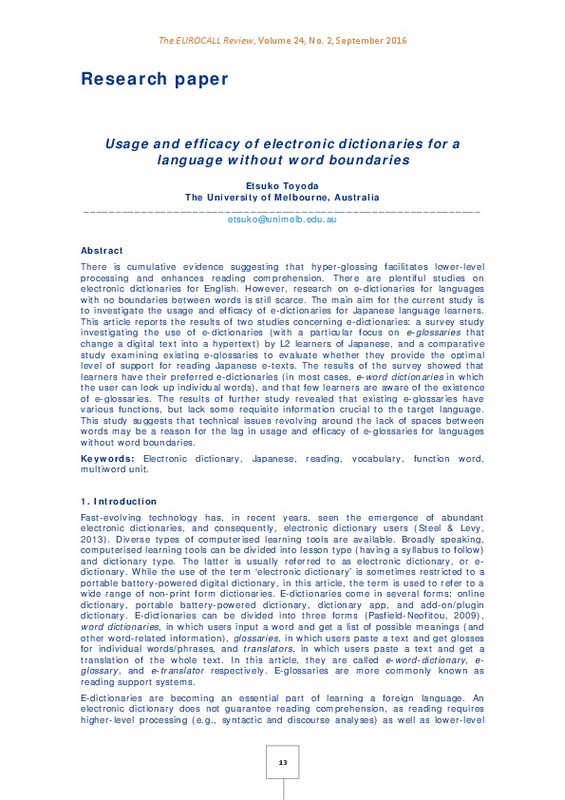AbuSeileek, A. F. (2011). Hypermedia annotation presentation: The effect of location and type on the EFL learners’ achievement in reading comprehension and vocabulary acquisition. Computers & Education, 57(1), 1281-1291. doi:10.1016/j.compedu.2011.01.011
Alderson, J. C. (2000). Assessing Reading. doi:10.1017/cbo9780511732935
Caleb. R. & Matsumoto, Y. (2011). The effect of lexical coverage and dictionary use on L2 reading comprehension, Reading Matrix, 11(3): 207-225.
[+]
AbuSeileek, A. F. (2011). Hypermedia annotation presentation: The effect of location and type on the EFL learners’ achievement in reading comprehension and vocabulary acquisition. Computers & Education, 57(1), 1281-1291. doi:10.1016/j.compedu.2011.01.011
Alderson, J. C. (2000). Assessing Reading. doi:10.1017/cbo9780511732935
Caleb. R. & Matsumoto, Y. (2011). The effect of lexical coverage and dictionary use on L2 reading comprehension, Reading Matrix, 11(3): 207-225.
Chen, I.-J., & Yen, J.-C. (2013). Hypertext annotation: Effects of presentation formats and learner proficiency on reading comprehension and vocabulary learning in foreign languages. Computers & Education, 63, 416-423. doi:10.1016/j.compedu.2013.01.005
Chun, D. M. (2001). L2 Reading on the Web: Strategies for Accessing Information in Hypermedia. Computer Assisted Language Learning, 14(5), 367-403. doi:10.1076/call.14.5.367.5775
Gettys, S., Imhof, L. A., & Kautz, J. O. (2001). Computer-Assisted Reading: The Effect of Glossing Format on Comprehension and Vocabulary Retention. Foreign Language Annals, 34(2), 91-99. doi:10.1111/j.1944-9720.2001.tb02815.x
Grabe, W. (2009). Reading in a Second Language: Moving from Theory to Practice. New York: Cambridge University Press.
Jeon, E. H., & Yamashita, J. (2014). L2 Reading Comprehension and Its Correlates: A Meta-Analysis. Language Learning, 64(1), 160-212. doi:10.1111/lang.12034
Jin L. & Deifell, E. (2013). Foreign language learners' use and perception of online dictionaries: A survey study. MERLOT Journal of Online Learning and Teaching, 9(4): 515-533.
Kato, S. [加藤重弘] (2006). Handbook of Japanese Grammar [日本語文法入門ハンドブック], Tokyo: Kenkyusha [研究社].
Koda, K. (1994). Second language reading research: Problems and possibilities. Applied Psycholinguistics, 15(1), 1-28. doi:10.1017/s0142716400006950
Liou, H.-C. (2000). The Electronic Bilingual Dictionary as a Reading Aid to EFL Learners: Research Findings and Implications. Computer Assisted Language Learning, 13(4-5), 467-476. doi:10.1076/0958-8221(200012)13:4-5;1-e;ft467
Lomicka, L. L. (1998). "To gloss or not to gloss": An investigation of reading comprehension online. Language Learning & Technology, 1(2): 41-50.
Nation, I. S. P. (2001). Learning Vocabulary in Another Language. doi:10.1017/cbo9781139524759
Pasfield-Neofitou, S. (2009). Paper, electronic or online?: Different dictionaries for different activities. Babel, 43(2): 12-18.
Şevik, M. (2014). University Prep-school EFL Learners’ Dictionary Ownership and Preferences. Procedia - Social and Behavioral Sciences, 158, 226-232. doi:10.1016/j.sbspro.2014.12.080
Steel, C. H., & Levy, M. (2013). Language students and their technologies: Charting the evolution 2006–2011. ReCALL, 25(3), 306-320. doi:10.1017/s0958344013000128
Shiotsu, T., & Weir, C. J. (2007). The relative significance of syntactic knowledge and vocabulary breadth in the prediction of reading comprehension test performance. Language Testing, 24(1), 99-128. doi:10.1177/0265532207071513
Yamauchi, H. [ 山内博之 ] (2008), Suggestions for Morphological Analysis: From the Perspective of Teaching Japanese [ 形態素解析に関する提案 — 日本語教育の視点から — ], Jissen Japanese Literature [實踐國文學 ], 73 : 152-141.
[-]








